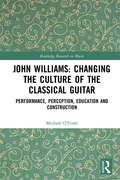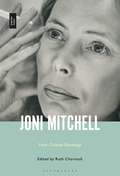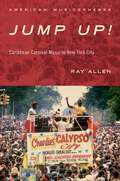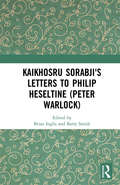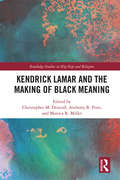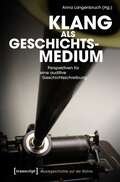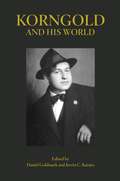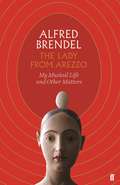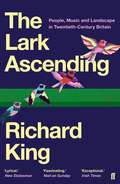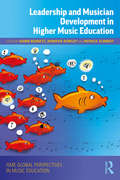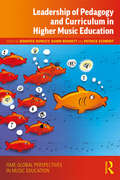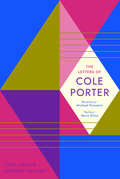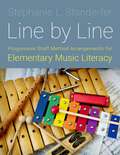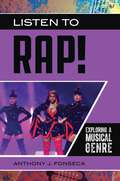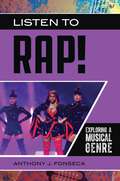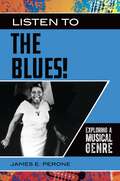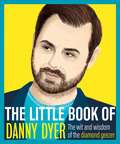- Table View
- List View
John Williams: Performance, perception, education and construction (Routledge Research in Music)
by Michael O'TooleThis book assesses the influence and reception of many different forms of guitar playing upon the classical guitar and more specifically through the prism of John Williams. Beginning with an examination of Andrés Segovia and his influence upon Williams’ life’s work, a further three incisive chapters cover key areas such as performance, perception, education and construction, considering social and cultural contexts of the guitar over the past century. A final chapter on new directions in classical guitar examines the change in reception of the instrument from the mid-1970s to the present day, and Williams’ impact upon what might be termed ‘standard classical guitar repertoire’. With in-depth discussion of the cultural and perceptual impact of Williams’ more daring crossover projects and numerous musical examples, this is an informative reference for all classical guitar practitioners, as well as scholars and researchers of guitar studies, reception studies, cultural musicology and performance studies. An online lecture by the author and a transcript of the author’s interview with John Williams are also available as e-resources.
John Williams: Performance, perception, education and construction (Routledge Research in Music)
by Michael O'TooleThis book assesses the influence and reception of many different forms of guitar playing upon the classical guitar and more specifically through the prism of John Williams. Beginning with an examination of Andrés Segovia and his influence upon Williams’ life’s work, a further three incisive chapters cover key areas such as performance, perception, education and construction, considering social and cultural contexts of the guitar over the past century. A final chapter on new directions in classical guitar examines the change in reception of the instrument from the mid-1970s to the present day, and Williams’ impact upon what might be termed ‘standard classical guitar repertoire’. With in-depth discussion of the cultural and perceptual impact of Williams’ more daring crossover projects and numerous musical examples, this is an informative reference for all classical guitar practitioners, as well as scholars and researchers of guitar studies, reception studies, cultural musicology and performance studies. An online lecture by the author and a transcript of the author’s interview with John Williams are also available as e-resources.
Joni Mitchell: New Critical Readings
by Dr Ruth CharnockJoni Mitchell: New Critical Readings recognizes the importance and innovativeness of the musician and artist Joni Mitchell and the need for a collection that theorizes her work as musician, composer, cultural commentator and antagonist. It showcases pieces by established and early career academics from the fields of popular music and literary studies on subjects such as Mitchell's guitar technique, the politics of aging in her work, and her fractious relationship with feminism. The collection features close readings of specific songs, albums, and performances while also paying keen attention to Mitchell's wider cultural contributions and significance.
Joni Mitchell: New Critical Readings
by Ruth CharnockJoni Mitchell: New Critical Readings recognizes the importance and innovativeness of the musician and artist Joni Mitchell and the need for a collection that theorizes her work as musician, composer, cultural commentator and antagonist. It showcases pieces by established and early career academics from the fields of popular music and literary studies on subjects such as Mitchell's guitar technique, the politics of aging in her work, and her fractious relationship with feminism. The collection features close readings of specific songs, albums, and performances while also paying keen attention to Mitchell's wider cultural contributions and significance.
JUMP UP! AM C: Caribbean Carnival Music in New York (American Musicspheres)
by Ray AllenJump Up! Caribbean Carnival Music in New York City is the first comprehensive history of Trinidadian calypso and steelband music in the diaspora. Carnival, transplanted from Trinidad to Harlem in the 1930s and to Brooklyn in the late 1960s, provides the cultural context for the study. Blending oral history, archival research, and ethnography, Jump Up! examines how members of New York's diverse Anglophile-Caribbean communities forged transnational identities through the self-conscious embrace and transformation of select Carnival music styles and performances. The work fills a significant void in our understanding of how Caribbean Carnival music-specifically calypso, soca (soul/calypso), and steelband-evolved in the second half of the twentieth century as it flowed between its Island homeland and its bourgeoning New York migrant community. Jump Up! addresses the issues of music, migration, and identity head on, exploring the complex cycling of musical practices and the back-and-forth movement of singers, musicians, arrangers, producers, and cultural entrepreneurs between New York's diasporic communities and the Caribbean.
Kaikhosru Sorabji's Letters to Philip Heseltine (Peter Warlock)
by Barry Smith Brian InglisTwo extraordinary personalities, and one remarkable friendship, are reflected in the unique corpus of letters from Anglo-Parsi composer-critic Kaikhosru Sorabji (1892-1988) to Philip Heseltine (Peter Warlock) (1894-1930): a fascinating primary source for the period 1913-1922 available in a complete scholarly edition for the first time. The volume also provides a new contextual, critical and interpretative framework, incorporating a myriad of perspectives: identities, social geographies, style construction, and mutual interests and influences. Pertinent period documents, including evidence of Heseltine’s reactions, enhance the sense of narrative and expand on aesthetic discussions. Through the letters’ entertaining and perceptive lens, Sorabji’s early life and compositions are vividly illuminated and Heseltine’s own intriguing life and work recontextualised. What emerges takes us beyond tropes of otherness and eccentricity to reveal a persona and a narrative with great relevance to modern-day debates on canonicity and identity, especially the nexus of ethnicity, queer identities and Western art music. Scholars, performers and admirers of early twentieth-century music in Britain, and beyond, will find this a valuable addition to the literature. The book will appeal to those studying or interested in early musical modernism and its reception; cultural life in London around and after the First World War; music, nationality and race; Commonwealth studies; and music and sexuality.
Kaikhosru Sorabji's Letters to Philip Heseltine (Peter Warlock)
by Barry Smith Brian InglisTwo extraordinary personalities, and one remarkable friendship, are reflected in the unique corpus of letters from Anglo-Parsi composer-critic Kaikhosru Sorabji (1892-1988) to Philip Heseltine (Peter Warlock) (1894-1930): a fascinating primary source for the period 1913-1922 available in a complete scholarly edition for the first time. The volume also provides a new contextual, critical and interpretative framework, incorporating a myriad of perspectives: identities, social geographies, style construction, and mutual interests and influences. Pertinent period documents, including evidence of Heseltine’s reactions, enhance the sense of narrative and expand on aesthetic discussions. Through the letters’ entertaining and perceptive lens, Sorabji’s early life and compositions are vividly illuminated and Heseltine’s own intriguing life and work recontextualised. What emerges takes us beyond tropes of otherness and eccentricity to reveal a persona and a narrative with great relevance to modern-day debates on canonicity and identity, especially the nexus of ethnicity, queer identities and Western art music. Scholars, performers and admirers of early twentieth-century music in Britain, and beyond, will find this a valuable addition to the literature. The book will appeal to those studying or interested in early musical modernism and its reception; cultural life in London around and after the First World War; music, nationality and race; Commonwealth studies; and music and sexuality.
Kendrick Lamar and the Making of Black Meaning (Routledge Studies in Hip Hop and Religion)
by Christopher M. Driscoll Monica R. Miller Anthony B. PinnKendrick Lamar has established himself at the forefront of contemporary hip-hop culture. Artistically adventurous and socially conscious, he has been unapologetic in using his art form, rap music, to address issues affecting black lives while also exploring subjects fundamental to the human experience, such as religious belief. This book is the first to provide an interdisciplinary academic analysis of the impact of Lamar’s corpus. In doing so, it highlights how Lamar’s music reflects current tensions that are keenly felt when dealing with the subjects of race, religion and politics. Starting with Section 80 and ending with DAMN., this book deals with each of Lamar’s four major projects in turn. A panel of academics, journalists and hip-hop practitioners show how religion, in particular black spiritualties, take a front-and-center role in his work. They also observe that his astute and biting thoughts on race and culture may come from an African American perspective, but many find something familiar in Lamar’s lyrical testimony across great chasms of social and geographical difference. This sophisticated exploration of one of popular culture’s emerging icons reveals a complex and multi faceted engagement with religion, faith, race, art and culture. As such, it will be vital reading for anyone working in religious, African American and hip-hop studies, as well as scholars of music, media and popular culture.
Kendrick Lamar and the Making of Black Meaning (Routledge Studies in Hip Hop and Religion)
by Christopher M. Driscoll Monica R. Miller Anthony B. PinnKendrick Lamar has established himself at the forefront of contemporary hip-hop culture. Artistically adventurous and socially conscious, he has been unapologetic in using his art form, rap music, to address issues affecting black lives while also exploring subjects fundamental to the human experience, such as religious belief. This book is the first to provide an interdisciplinary academic analysis of the impact of Lamar’s corpus. In doing so, it highlights how Lamar’s music reflects current tensions that are keenly felt when dealing with the subjects of race, religion and politics. Starting with Section 80 and ending with DAMN., this book deals with each of Lamar’s four major projects in turn. A panel of academics, journalists and hip-hop practitioners show how religion, in particular black spiritualties, take a front-and-center role in his work. They also observe that his astute and biting thoughts on race and culture may come from an African American perspective, but many find something familiar in Lamar’s lyrical testimony across great chasms of social and geographical difference. This sophisticated exploration of one of popular culture’s emerging icons reveals a complex and multi faceted engagement with religion, faith, race, art and culture. As such, it will be vital reading for anyone working in religious, African American and hip-hop studies, as well as scholars of music, media and popular culture.
Klang als Geschichtsmedium: Perspektiven für eine auditive Geschichtsschreibung (Musikgeschichte auf der Bühne #1)
by Anna LangenbruchKonstruieren Klänge Geschichte? Die Beiträge dieses Bandes etablieren und reflektieren Klang als Kategorie der Geschichtsschreibung, indem sie historische Wissensproduktion als klangliche Praxis untersuchen. Es geht dabei weniger um eine Neubewertung des auditiven Ausschnitts vergangener Wirklichkeiten, sondern um einen Perspektivwechsel in der Geschichtsschreibung: Im Zentrum steht die Frage, wie Menschen Klänge wahrnehmen, benutzen, inszenieren, deuten, erinnern - und zu historischen Wissenskonzepten verknüpfen. Musikgeschichte als Geschichte einer Klangkunst dient dabei als ein Kristallisationspunkt, der die interdisziplinäre Diskussion in einem besonders prägnanten Beispiel bündelt.
Korngold and His World (The\bard Music Festival Ser. #45)
by Daniel Goldmark Kevin C. KarnesA brand-new look at the life and music of renowned composer Erich Wolfgang KorngoldErich Wolfgang Korngold (1897–1957) was the last compositional prodigy to emerge from the Austro-German tradition of Mozart and Mendelssohn. He was lauded in his youth by everyone from Mahler to Puccini and his auspicious career in the early 1900s spanned chamber music, opera, and musical theater. Today, he is best known for his Hollywood film scores, composed between 1935 and 1947. From his prewar operas in Vienna to his pathbreaking contributions to American film, Korngold and His World provides a substantial reassessment of Korngold’s life and accomplishments.Korngold struggled to reconcile the musical language of his Viennese upbringing with American popular song and cinema, and was forced to adapt to a new life after wartime emigration to Hollywood. This collection examines Korngold’s operas and film scores, the critical reception of his music, and his place in the milieus of both the Old and New Worlds. The volume also features numerous historical documents—many previously unpublished and in first-ever English translations—including essays by the composer as well as memoirs by his wife, Luzi Korngold, and his father, the renowned music critic Julius Korngold.The contributors are Leon Botstein, David Brodbeck, Bryan Gilliam, Daniel Goldmark, Lily Hirsch, Kevin Karnes, Sherry Lee, Neil Lerner, Sadie Menicanin, Ben Winters, Amy Wlodarski, and Charles Youmans.Bard Music Festival 2019Korngold and His WorldBard CollegeAugust 9–11 and 16–18, 2019
Korngold and His World (The\bard Music Festival Ser. #45)
by Daniel Goldmark Kevin C. KarnesA brand-new look at the life and music of renowned composer Erich Wolfgang KorngoldErich Wolfgang Korngold (1897–1957) was the last compositional prodigy to emerge from the Austro-German tradition of Mozart and Mendelssohn. He was lauded in his youth by everyone from Mahler to Puccini and his auspicious career in the early 1900s spanned chamber music, opera, and musical theater. Today, he is best known for his Hollywood film scores, composed between 1935 and 1947. From his prewar operas in Vienna to his pathbreaking contributions to American film, Korngold and His World provides a substantial reassessment of Korngold’s life and accomplishments.Korngold struggled to reconcile the musical language of his Viennese upbringing with American popular song and cinema, and was forced to adapt to a new life after wartime emigration to Hollywood. This collection examines Korngold’s operas and film scores, the critical reception of his music, and his place in the milieus of both the Old and New Worlds. The volume also features numerous historical documents—many previously unpublished and in first-ever English translations—including essays by the composer as well as memoirs by his wife, Luzi Korngold, and his father, the renowned music critic Julius Korngold.The contributors are Leon Botstein, David Brodbeck, Bryan Gilliam, Daniel Goldmark, Lily Hirsch, Kevin Karnes, Sherry Lee, Neil Lerner, Sadie Menicanin, Ben Winters, Amy Wlodarski, and Charles Youmans.Bard Music Festival 2019Korngold and His WorldBard CollegeAugust 9–11 and 16–18, 2019
The Lady from Arezzo: My Musical Life and Other Matters
by Alfred BrendelThe title of this collection of essays refers to a tailor's mannequin that Alfred Brendel spotted in a shop window in Arezzo, a small Tuscan town. Who is this strange lady? What is she looking at? And why is she carrying an egg on her head? The mannequin now graces a room in the attic of Brendel's house in Hampstead. Her features convey great artistic seriousness in combination with absurd comedy: the epitome of his own musical and literary preferences. And so, in his delightful new collection, great masters of nonsense meet great masters of music.
The Lark Ascending: The Music of the British Landscape
by Richard KingOriginally from Newport, Gwent, for the last eighteen years Richard King has lived in the hill farming country of Radnosrshire, Powys. He is the author of Original Rockers, which was shortlisted for the Gordon Burn Prize, and How Soon Is Now?, both published by Faber.
Leadership and Musician Development in Higher Music Education (ISME Global Perspectives in Music Education Series)
by Dawn Bennett Jennifer Rowley Patrick SchmidtLeadership and Musician Development in Higher Music Education informs, challenges and evaluates the central practices, policies and theories that underpin the preparation of future music leaders and the leadership of music in higher education. In higher education, it is often presumed that preparing for professional work is the responsibility of the individual rather than the institution. This anthology draws on the expertise of music practitioners to present the complexities surrounding this topic, exploring approaches to leadership development while addressing prevalent leadership issues from multiple standpoints. Leadership is an inherent part of being a musician: from the creative act through to collaborative engagement, it is fundamental to creating and sustaining a career in music. To expect musicians to develop these necessary skills "on the job", however, is unreasonable and impractical. What support might be given to those looking to negotiate a career as a musician? In fourteen essays, contributors from around the globe explore this question and more, questions such as: How might leadership be modelled for aspiring musicians? How might students learn to recognise, appraise and extend their leadership development? How might institutional leaders challenge curricular and pedagogical norms? Effective leadership development for musicians is vital to the longevity of the profession – Leadership and Musician Development in Higher Music Education is a likewise vital resource for students, educators and future music leaders alike.
Leadership and Musician Development in Higher Music Education (ISME Global Perspectives in Music Education Series)
by Dawn Bennett Jennifer Rowley Patrick SchmidtLeadership and Musician Development in Higher Music Education informs, challenges and evaluates the central practices, policies and theories that underpin the preparation of future music leaders and the leadership of music in higher education. In higher education, it is often presumed that preparing for professional work is the responsibility of the individual rather than the institution. This anthology draws on the expertise of music practitioners to present the complexities surrounding this topic, exploring approaches to leadership development while addressing prevalent leadership issues from multiple standpoints. Leadership is an inherent part of being a musician: from the creative act through to collaborative engagement, it is fundamental to creating and sustaining a career in music. To expect musicians to develop these necessary skills "on the job", however, is unreasonable and impractical. What support might be given to those looking to negotiate a career as a musician? In fourteen essays, contributors from around the globe explore this question and more, questions such as: How might leadership be modelled for aspiring musicians? How might students learn to recognise, appraise and extend their leadership development? How might institutional leaders challenge curricular and pedagogical norms? Effective leadership development for musicians is vital to the longevity of the profession – Leadership and Musician Development in Higher Music Education is a likewise vital resource for students, educators and future music leaders alike.
Leadership of Pedagogy and Curriculum in Higher Music Education (ISME Global Perspectives in Music Education Series)
by Jennifer Rowley Dawn Bennett Patrick SchmidtLeadership of Pedagogy and Curriculum in Higher Music Education is the second of a two-volume anthology dedicated to leadership and leadership development in higher music education. Fifteen authors write from multiple countries and contexts, exploring pedagogical and curricular leadership challenges and successes from around the globe. They draw attention to the dynamics of pedagogical approaches which encourage learners’ deep and agentic engagement, considering the sustainability and scope of such interventions while highlighting positive frameworks and approaches. As with its companion volume, Leadership of Pedagogy and Curriculum in Higher Music Education includes student commentary in which student contributors give concrete ideas and recommendations for facilitating and strengthening leadership development through practical and equitable strategies with students, communities and colleagues. The outcome is a collection of essays designed to offer student musicians, higher education teachers and institutional leaders theoretically informed and practical insights into the development and practice of leadership.
Leadership of Pedagogy and Curriculum in Higher Music Education (ISME Global Perspectives in Music Education Series)
by Jennifer Rowley Dawn Bennett Patrick SchmidtLeadership of Pedagogy and Curriculum in Higher Music Education is the second of a two-volume anthology dedicated to leadership and leadership development in higher music education. Fifteen authors write from multiple countries and contexts, exploring pedagogical and curricular leadership challenges and successes from around the globe. They draw attention to the dynamics of pedagogical approaches which encourage learners’ deep and agentic engagement, considering the sustainability and scope of such interventions while highlighting positive frameworks and approaches. As with its companion volume, Leadership of Pedagogy and Curriculum in Higher Music Education includes student commentary in which student contributors give concrete ideas and recommendations for facilitating and strengthening leadership development through practical and equitable strategies with students, communities and colleagues. The outcome is a collection of essays designed to offer student musicians, higher education teachers and institutional leaders theoretically informed and practical insights into the development and practice of leadership.
The Letters of Cole Porter
by Cole PorterThe first comprehensive collection of the letters of one of the most successful American songwriters of the twentieth century From Anything Goes to Kiss Me, Kate, Cole Porter left a lasting legacy of iconic songs including "You're the Top," "Love For Sale," and "Night and Day." Yet, alongside his professional success, Porter led an eclectic personal life which featured exuberant parties, scandalous affairs, and chronic health problems. This extensive collection of letters (most of which are published here for the first time) dates from the first decade of the twentieth century to the early 1960s and features correspondence with stars such as Irving Berlin, Ethel Merman, and Orson Welles, as well as his friends and lovers. Cliff Eisen and Dominic McHugh complement these letters with lively commentaries that draw together the loose threads of Porter’s life and highlight the distinctions between Porter’s public and private existence. This book reveals surprising insights into his attitudes toward Hollywood and Broadway, and toward money, love, and dazzling success.
LINE BY LINE C: Progressive Staff Method Arrangements for Elementary Music Literacy
by Stephanie L. StanderferIn Line by Line, author Stephanie L. Standerfer harnesses years of pedagogical expertise in a practical guide to promote music learning by experience rather than imitation and memorization. Using well-known songs and a variety of instrumental accompaniments for all skill levels, lesson plans encourage students to first learn music conceptually by internalizing the sound and feeling before learning musical symbols. The lesson plans are tailored for five to seven spiraled class periods and take every student into consideration by suggesting ways to address specific student needs for those who need more time to process.
Listen to Rap!: Exploring a Musical Genre (Exploring Musical Genres)
by Anthony J. FonsecaListen to Rap! Exploring a Musical Genre provides an overview of this kinetic and poetic musical genre for scholars of rap and curious novices alike.Listen to Rap! Exploring a Musical Genre discusses the 50 most influential, commercially successful, and important rappers, rap crews (bands), rap albums, and rap singles. Rap began as an American phenomenon, so the book's emphasis is on Americans, although it also includes information on Canadian, British, Indian, and African rappers and crews. Its organization makes information easily accessible for readers, and the emphasis on the sound of the music gives readers a new angle from which to appreciate the music. Unlike other titles in the series, this volume concentrates solely on rap music. Included in the book are rappers who range from the earliest practitioners of the genre to rappers who are redefining the genre today. A background section introduces the genre, while a legacy section shows how rap has cemented its place in the world. Additionally, another section shows the tremendous impact rap has had on popular culture.
Listen to Rap!: Exploring a Musical Genre (Exploring Musical Genres)
by Anthony J. FonsecaListen to Rap! Exploring a Musical Genre provides an overview of this kinetic and poetic musical genre for scholars of rap and curious novices alike.Listen to Rap! Exploring a Musical Genre discusses the 50 most influential, commercially successful, and important rappers, rap crews (bands), rap albums, and rap singles. Rap began as an American phenomenon, so the book's emphasis is on Americans, although it also includes information on Canadian, British, Indian, and African rappers and crews. Its organization makes information easily accessible for readers, and the emphasis on the sound of the music gives readers a new angle from which to appreciate the music. Unlike other titles in the series, this volume concentrates solely on rap music. Included in the book are rappers who range from the earliest practitioners of the genre to rappers who are redefining the genre today. A background section introduces the genre, while a legacy section shows how rap has cemented its place in the world. Additionally, another section shows the tremendous impact rap has had on popular culture.
Listen to the Blues!: Exploring a Musical Genre (Exploring Musical Genres)
by James E. PeroneListen to the Blues! Exploring A Musical Genre provides an overview of this distinctly American musical genre for fans of the blues and curious readers alike, with a focus on 50 must-hear artists, albums, and subgenres.Unlike other books on the blues, which tend to focus on musician biographies, Listen to the Blues! devotes time to the compositions, recordings, and musical legacies of blues musicians from the early 20th century to the present. Although the author references musical structure, harmony, form, and other musical concepts, the volume avoids technical language; therefore, it is a volume that should be of interest to the casual blues fan, to students of blues music and its history, and to more serious blues fans. The chapters on the impact of the blues on popular culture and the legacy of the blues also put the genre in a broader historical context than what is found in many books on the blues.The book opens with a background chapter that provides an overview of the history and structure of blues music. A substantial, encyclopedic chapter that focuses on 50 must-hear blues musicians follows, as does a chapter that explores the impact on popular culture of blues music and musicians and a chapter that focuses on the legacy of the genre. A bibliography rounds out the work.
Listen to the Blues!: Exploring a Musical Genre (Exploring Musical Genres)
by James E. PeroneListen to the Blues! Exploring A Musical Genre provides an overview of this distinctly American musical genre for fans of the blues and curious readers alike, with a focus on 50 must-hear artists, albums, and subgenres.Unlike other books on the blues, which tend to focus on musician biographies, Listen to the Blues! devotes time to the compositions, recordings, and musical legacies of blues musicians from the early 20th century to the present. Although the author references musical structure, harmony, form, and other musical concepts, the volume avoids technical language; therefore, it is a volume that should be of interest to the casual blues fan, to students of blues music and its history, and to more serious blues fans. The chapters on the impact of the blues on popular culture and the legacy of the blues also put the genre in a broader historical context than what is found in many books on the blues.The book opens with a background chapter that provides an overview of the history and structure of blues music. A substantial, encyclopedic chapter that focuses on 50 must-hear blues musicians follows, as does a chapter that explores the impact on popular culture of blues music and musicians and a chapter that focuses on the legacy of the genre. A bibliography rounds out the work.
The Little Book of Danny Dyer: The wit and wisdom of the diamond geezer
by Various'If the body is a temple, at the moment mine's a windowless shed.'Danny Dyer, actor and descendant of William the Conqueror, is the nation's favourite geezer well known for his cutting one-liners and amusing outbursts and, with them, he has captured all of our hearts. The Little Book of Danny Dyer is a collection of his most iconic quotes on politics, fitness, parenting and the important things in life.From Brexit to philosophising about how we wouldn't be able to eat sandwiches if we didn't have thumbs, The Little Book of Danny Dyer is the perfect gift for fans of this wise-cracking national treasure.
